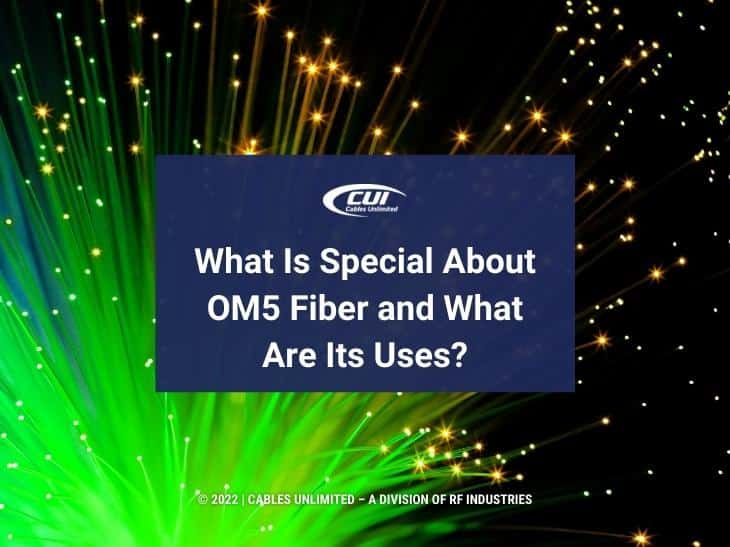As fiber optic cables continue to advance, it can be challenging to distinguish between the latest versions. The topic of this article, OM5 fiber, is a multimode fiber cable designed for high bandwidth and short to medium-range applications. It’s the first approved wideband multimode fiber (WBMMF) for applications that use two fibers to transmit from 40 GBs to 100 GBs using shortwave wavelength division multiplexing (SWDM).
This article compares the different types of OM fiber cables, highlights the advantages of OM5 fiber, and discusses the full range of applications.
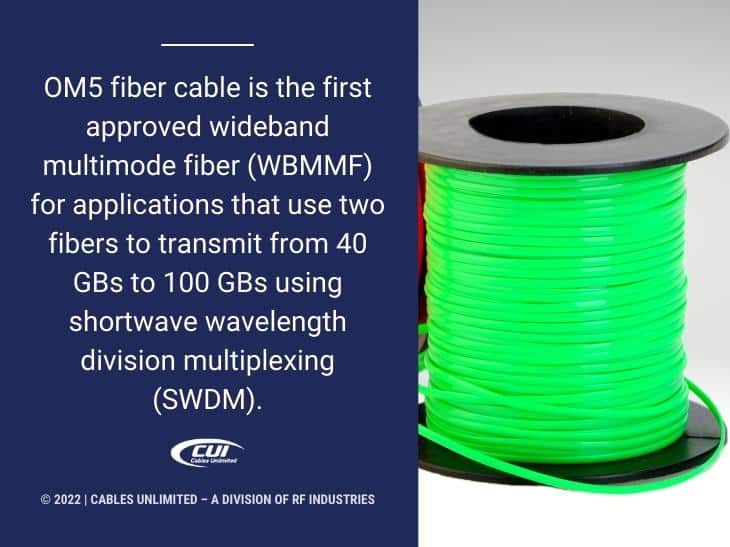
OM Fiber Comparison
Before we examine OM5 fiber further, here are the other OM versions for comparison.
| Multimode Fiber | Color | Typical Data Rate | Bandwidth | Distance |
| OM1 | Orange | 100 MB at 850 nm | 200 MHz | Up to 33 meters |
| OM2 | Orange | 1 GB at 850 nm | 500 MHz | Up to 82 meters |
| OM3 | Aqua | 10 GB at 850 nm | 2000 MHz | Up to 300 meters |
| OM4 | Aqua | 40 GB at 850 nm | 4700 MHz | Up to 550 meters |
| OM5 | Lime | 100 GB at 850 to 950 nm | 28000 MHz | Up to 500 meters |
The big difference for OM5 is that it can handle at least four WDM channels across the range of 850 to 950 nm. The OM1 to OM4 fibers can handle only one channel. Another difference is the fiber diameter with OM1 at 62.5 µm and OM2 through OM5 at 50 µm.
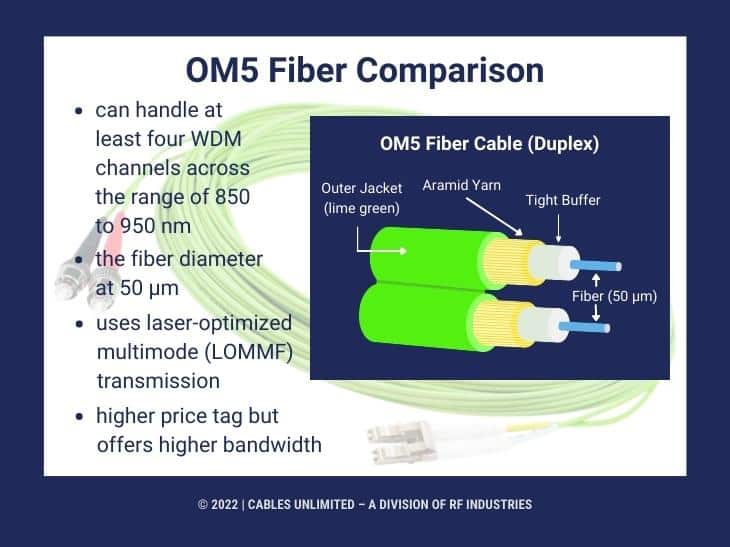
Note that OM1 and OM2 are designed for LED transmitters that provide lower costs but also limit their bandwidth. OM3, OM4, and OM5 use laser-optimized multimode (LOMMF) transmission. That comes with a higher price tag but offers higher bandwidth.
OS2 fiber is the best option for long distances, with transmission rates over 10 GB and distances of up to 200 km. OS1 can only reach 2 km distances. OS fibers are single-mode, while OM fibers are multimode.
OM5 Fiber Advantages
OM5 fiber can use four separate wavelengths with consistent and lower channel loss plus reduced crosstalk due to fewer fibers. This multiplexing reduces the required parallel fiber counts as one OM5 pair can provide four data streams. This reduces cable count and cost. In that way, it also helps with cable management and space challenges.
OM5 fiber is also compatible with OM3 and OM4 systems, allowing incremental upgrades without replacing the existing infrastructure.
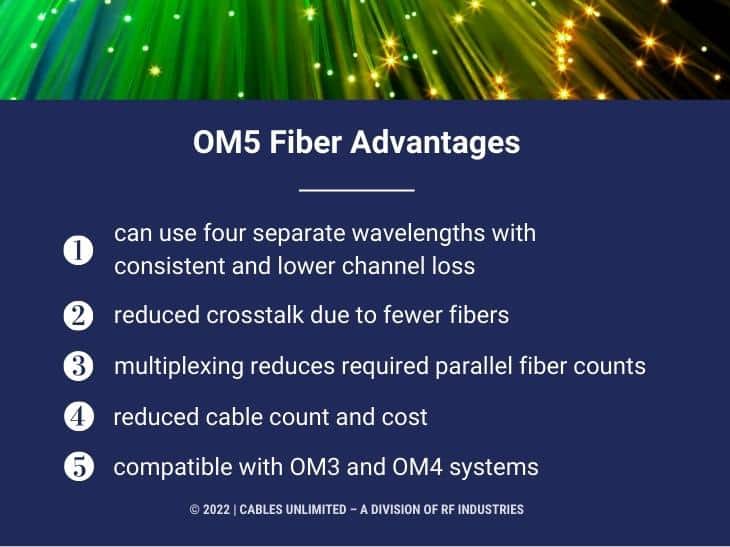
OM5 Fiber Applications
OM5 fiber is ideal for high-speed data environments. That primarily includes data centers in their never-ending drive toward greater bandwidth, higher speeds, and higher density. With OM5’s capability of reducing the number of cables by a factor of four, it can help significantly in increasing capacity while maintaining or even reducing the required footprint.
In addition, all multimode fibers are very cost-effective for installation inside buildings. Single-mode fibers are best for long-distance outside runs.
OM5 fiber is installed in a wide range of cable assemblies, including trunk cables and fiber optic backbones. They are also used in cell phone and Internet infrastructure build-outs. That includes small cell cables and fiber optic patch cables.
Read more in our blog: Custom Indoor Network Patch Cables: Everything You Need to Know
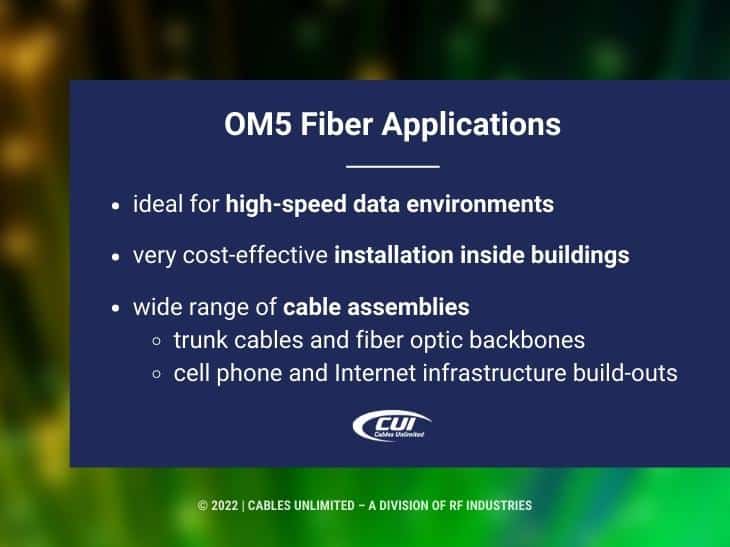
We Can Help with Your Fiber Cable Selection
We’ve got you covered for fiber optic cable assemblies. The list includes DAS cables, trunk cables, patch cables, MTP®/MPO cables, macro cables, small cell cables, OptiFlex™ Hybrid Composite Cables, IP outdoor rated cable assemblies, and custom fiber optic cables.
If your requirements are already specified and ready for a quote for your current projects, we are prepared to meet your deadlines and pricing targets. Our extensive in-house services and advanced manufacturing capabilities are in place to meet your requirements.
But Cables-Unlimited offers much more than USA state-of-the-art manufacturing – our dedicated team is also known for going to great lengths to meet the needs of our customers, including working round-the-clock to meet tight turnaround time requirements.
Our sales representatives are standing by to assist you with product questions and quotes Monday – Friday, 8:00 am to 5:00 pm Eastern. You can also send us an email or complete our contact form, and we’ll get right back to you.

